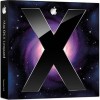Apple MB427Z-A Installation Guide - Page 13
Answers to Common Questions, Installing Mac OS X
 |
UPC - 885909216468
View all Apple MB427Z-A manuals
Add to My Manuals
Save this manual to your list of manuals |
Page 13 highlights
Answers to Common Questions Use the following sections to find answers to questions you may have about installing and using Mac OS X. Installing Mac OS X You want to quit the installer. 1 Choose Mac OS X Installer > Quit Mac OS X Installer, and then click Startup Disk. 2 Select the startup disk you want to use, and then click Restart. WARNING: If you're installing Mac OS X on your current Mac OS X startup disk, let the installer finish. If you quit, you may not be able to start up using your current Mac OS X startup disk. You want to use the keyboard instead of the mouse. You have full keyboard access while using the installer and Mac OS X Setup Assistant. Press the Tab key to highlight buttons, pop-up menus, and other options. Press the Down Arrow key to open pop-up menus. Press the Space bar to select items. You're not allowed to start the installer. If your computer is connected to a network, your network administrator may prevent you from installing software or upgrading Mac OS X. The installer doesn't open. If the installer doesn't open, restart your computer while holding down the C key to start up your computer using the install disc. If the installer still doesn't appear, restart your computer and hold down the mouse button or trackpad button to eject the disc. After your computer starts up, insert the Mac OS X Install disc. Use Startup Disk preferences to select the Install disc as your startup disk, and then restart. The installer can't repair your disk. If a message says the installer can't repair the disk, you may need to erase it. This deletes all the files on your disk. WARNING: If you erase the destination volume, everything on the volume-your user accounts, network settings, and all of your files and folders-will be deleted. If necessary, quit the installer and back up your files before you erase the destination volume. Before you erase your disk, you can quit the installer and back up desired files (copy them to another disk). When you're ready to erase the disk, open the installer, follow the instructions in "Custom Installations" on page 4, and select "Erase and Install." 13













